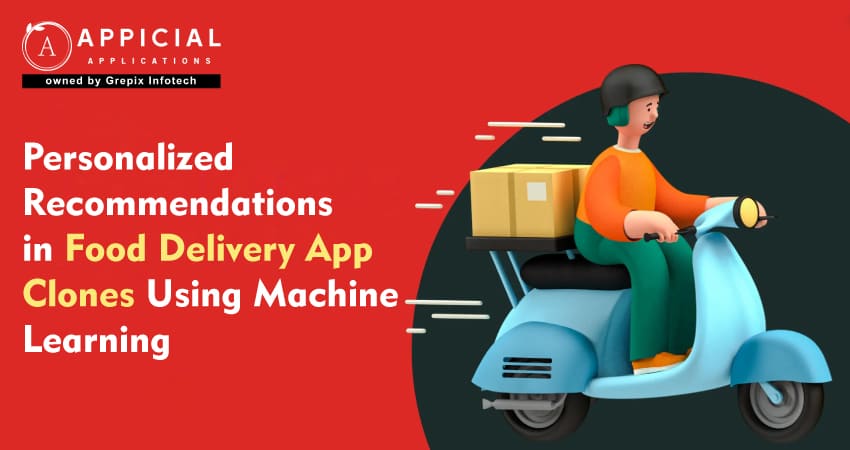
Personalized Recommendations in Food Delivery App Clones Using Machine Learning
Let’s be honest, choosing what to eat is sometimes harder than cooking it.
We scroll, we swipe, we sigh… and still end up ordering the same old burger.
Sound familiar?
But what if your food app knew exactly what you were craving, even before you did?
Well, it’s not magic. It’s machine learning food recommendations, and they’re quietly reshaping how we interact with food delivery apps. And when you replicate successful platforms with food app clone personalization, you’re not just copying, you’re evolving.
Pull up a chair, grab a coffee (or pizza), and let’s dive deep into how personalized food app experiences are getting a major upgrade,thanks to AI, clever algorithms, and a dash of human intuition.
In the fast-paced food delivery space, personalization is no longer a luxury; it’s expected. This blog explores how machine learning food recommendations are changing the game for personalized food app experiences, especially in food app clone personalization. We’ll cover how machine learning drives personalization, boosts user experience, and how it’s being implemented in real-world apps. Plus, we’ll explore successful case studies and wrap it all up with a spotlight on Appicial Applications, your go-to partner for custom, AI-powered app solutions.
Role of Machine Learning in Personalization
Here’s the thing: personalization isn’t just putting someone’s name at the top of a screen. It’s about relevance.
When done right, it feels like the app is reading your mind. When done wrong, it feels like spam.
So, what makes the difference? Enter machine learning food recommendations.
1 Understanding Behavior Through Data
Machine learning gobbles up user data like a midnight snack. Every tap, scroll, like, and order tells a story:
- Do you order vegan food on Tuesdays?
- Are you a sucker for desserts at night?
- Do you try something new every weekend?
ML models learn these patterns over time. Unlike static filters, they adapt,constantly refining predictions with each new interaction.
2 Predictive Algorithms in Action
You’re probably already familiar with collaborative filtering and content-based filtering, even if you don’t know it by name.
- Collaborative filtering: “People who liked X also liked Y.”
- Content-based filtering: “You liked spicy Indian food, here are more spicy dishes.”
Mix them, and you’ve got hybrid models, more robust, less prone to bias.
These algorithms sit quietly behind the scenes of every good personalized food app, serving up delicious suggestions based on behavior, context, and timing.
3 Real-Time Learning
Good recommendation engines evolve. Great ones learn on the fly.
With reinforcement learning and real-time model updates, apps can react to your latest mood swings. So if you suddenly go keto, the app won't keep showing you cheesecake for weeks. Smart, right?
Enhancing User Experience
The truth? Personalization isn’t just cool,it keeps people coming back. Let’s explore how food app clone personalization boosts the overall experience.
1 Killing the Choice Overload
Too many options are a real problem. We think we want variety… until we freeze at 2,000 menu items.
By narrowing down choices based on preferences, location, and habits, apps reduce friction. Users spend less time deciding, more time enjoying.
2 Driving Engagement with Smart Nudges
Imagine logging into a personalized food app and seeing:
- “Hey Sam, it’s your sushi day!”
- “Your usual Thai place has a 20% off today.”
- “Last week you rated pasta 5-stars, want more like that?”
These nudges aren’t annoying, they’re relevant. They feel personal, not robotic. And they drastically improve click-through rates and conversions.
3 Improving Customer Retention
Customers are loyal to convenience and familiarity. When a food app clone's personalization makes someone feel “known,” they’re less likely to hop to a competitor.
The result? More orders, more loyalty, and fewer cart abandonments.
4 Customizing UI Based on Preferences
Machine learning can even influence design elements:
- Surfacing “favorites” on home screens
- Tailoring promotions based on order history
- Prioritizing dietary needs (e.g., showing gluten-free dishes first)
It’s all about making the app feel yours, not just “another delivery platform.”
Implementation Strategies to Look Out For
So you’ve got the idea. You want to bring machine learning food recommendations into your personalized food app. Great. But where do you even start?
Let’s roll up our sleeves and dig into the practical stuff, what actually goes into building a food app clone personalization that isn’t just surface level fluff.
This part’s less glamorous, but it’s where the real magic happens.
1 Start with the Right Data
You’ve heard it before: garbage in, garbage out.
If your data isn’t clean, relevant, or rich enough, your personalization strategy will fall flat. Think of machine learning like a chef; it can only cook with the ingredients you give it.
So, what should you be tracking?
- Order history: What users have ordered in the past gives strong clues for what they’ll want next. Repeated patterns? That’s gold.
- Time of order: Some users are late-night snackers, others are lunch-hour loyalists. Use that info.
- Favorite cuisines: If someone keeps tapping Mexican, maybe don’t push sushi at them every time.
- Browsing patterns: What users look at, even if they don’t order ,says a lot. Hover time, search filters, scroll depth? All valuable signals.
- Ratings and reviews: Feedback is insight. A user who gave 5 stars to vegan burritos is probably into plant-based food.
- Location data: This is touchy. But if users opt in, you can suggest hyper-local options that actually deliver to them fast.
The point is, don’t guess. Let data tell the story. Then feed that story into your ML models to drive smarter suggestions.
2 Choose the Right Machine Learning Models
Don’t worry,this isn’t a science fair project. You don’t need to build everything from scratch. But you do need to understand which type of machine learning fits your use case.
Here’s a quick cheat sheet:
- Supervised Learning: You feed the model labeled data (like past ratings) and it learns to predict outcomes (like what new dishes a user might like). Great for starter personalization.
- Unsupervised Learning: No labels here. The model digs through your data and finds hidden groupings. This is powerful for customer segmentation, grouping people with similar ordering behavior.
- Reinforcement Learning: This one’s a bit cooler. It learns over time, adjusting its recommendations based on what works. Think of it like trial-and-error learning: did the user click or not? Did they reorder? These actions become rewards or penalties.
And here’s a pro tip: A/B test everything.
Run multiple recommendation models and see which ones actually drive more clicks, conversions, or reorders. Don’t guess. Let results guide you.
As your personalized food app scales, consider hybrid models, mixing and matching algorithms to get the best of each world. That’s when personalization starts feeling like actual magic.
3 Integrate with Backend & APIs
This is the part where your app starts thinking on its own, kind of.
Most modern apps are built on modular backends, which makes plugging in ML engines fairly straightforward (if you know what you’re doing).
You’ll want to:
- Fetch personalized recommendations from the ML model via API calls
- Update user profiles dynamically with each new interaction, ordering, rating,or browsing
- Serve dynamic content on the fly (homepages that shift per user, push notifications that feel handpicked)
At first, you can experiment with third-party ML-as-a-service tools. They’re fast, easy to integrate, and ideal for MVPs or testing ideas. But as you grow, you’ll likely want to build your own in-house models tailored to your unique customer base and behavior patterns.
Also, don’t forget about caching. ML predictions can be computationally expensive. Cache results for faster delivery, because no one likes waiting 5 seconds for their butter chicken recommendation to load.
4 Privacy-First Design
Let’s get real, trust is currency now.
Users are smarter than ever about data privacy. They’ll ask:
- “Why does this app want my location?”
- “Are my preferences being shared?”
- “Can I turn this off?”
And they should. That’s healthy. As a business, your job is to not just say “we care about privacy” but actually build it into your UX.
Here’s what that looks like in practice:
- Transparent data collection: Tell users what you’re collecting and why. No fine-print nonsense.
- Opt-in personalization: Don’t force it. Let users choose to personalize their experience. Many will say yes if you explain the value clearly.
- Editable preferences: Let people change their dietary filters, allergies, or cuisine interests anytime.
- Anonymize where possible: Train models on aggregated trends, not individual identities, when it’s not necessary.
- Comply with GDPR/CCPA: Even if you’re not in Europe or California, it’s best to follow the highest privacy standards. It shows you care, and it avoids future legal headaches.
Bottom line? Personalization without privacy feels invasive. When you build your food app clone personalization strategy with consent and clarity, you’re not just being ethical, you’re being smart.
Case Studies: Real-World Impact of Food App Clone Personalization
Let’s move beyond theory and peek at some practical wins in personalized food app design.
Case Study 1: ZestyClone Regional Cuisine Meets Localized ML
ZestyClone is a food app clone built to serve Tier-2 Indian cities. They wanted something simple but sharp.
By training ML models on region-specific cuisines and religious food habits (e.g., Jain, Halal), ZestyClone saw:
- 31% increase in daily orders
- 2x higher click-through on recommended dishes
- A decrease in search usage by 40% (because the homepage nailed it)
Their insight? Hyper-localization + smart filtering is gold.
Also Read: Augmented Reality (AR) in Food Delivery App Clones: Visualizing Your Meal
Case Study 2: BiteMate Fighting Customer Churn with Feedback Loops
BiteMate built an in-app feedback loop: Every time a user ordered, they were asked to rate based on taste, delivery, and portion size.
Those ratings went directly into an ML pipeline. The model refined future suggestions, adjusted vendor ratings, and removed underperforming dishes.
Results:
- 21% increase in reorder rates
- 37% drop in cart abandonment
- Vendors improved consistency to stay ranked
This was food app clone personalization done right, learning from real, living, human feedback.
Case Study 3: QuickFeast Real-Time Offers via Predictive Behavior
QuickFeast wasn’t the cheapest app in town. But they played it smart.
Their model analyzed time of day behavior and sent highly-targeted offers:
- “Your biryani from SpiceHub is 20% off, expires in 30 mins.”
- “Missed breakfast? Here’s a healthy wrap for lunch.”
Personalized nudges boosted:
- 45% higher response to limited-time offers
- 18% lift in revenue per user
Proof that machine learning food recommendations don’t just improve UX, they grow the bottom line.
Why Appicial Applications Should Be Your Go To
You’ve made it this far. You get it now,personalized food app experiences aren’t a gimmick. They’re the future.
But here’s the deal: Not every developer knows how to build these kinds of smart systems. It’s one thing to clone a food app. It’s another to elevate it with true food app clone personalization and machine learning food recommendations.
That’s where Appicial Applications comes in.
Why Choose Appicial?
- Proven expertise in AI-driven mobile apps
- Fully customizable food delivery app clones with personalization baked in
- Ready-to-launch solutions AND enterprise-scale integrations
- Transparent pricing, future-ready tech stack, and rock-solid support
Whether you’re a startup testing waters or a brand expanding reach, Appicial’s got your back.
Let them handle the tech. You focus on building your brand, feeding your customers, and owning your niche.
Final Thoughts: Personalization is the Secret Sauce
Food delivery is evolving fast, and the winners won’t just be the fastest or cheapest. They’ll be the ones who know their users best.
If you’re serious about growing in this space, you need more than just a clone,you need a smart, responsive, and empathetic personalized food app.
And it starts with machine learning food recommendations, real-time insights, and intelligent food app clone personalization strategies.
Your users are hungry, not just for food, but for an experience that feels crafted just for them.
So serve it up.
And when you're ready to cook something big? Visit Appicial Applications. They'll bring the recipe.
Looking out to start your own venture like Zomato? Try out our MasalaDish Zomato Clone, the easiest way to kick-start your taxi business.Author's Bio

Vinay Jain is the Founder at Grepix Infotech and brings over 12 years of entrepreneurial experience. His focus revolves around software & business development and customer satisfaction.
Back to blog list




